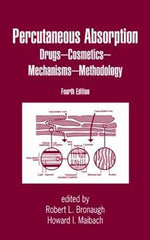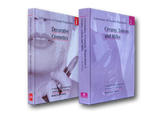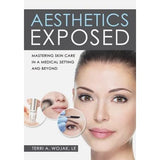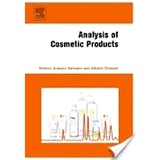Percutaneous Absorption: Drugs, Cosmetics, Mechanisms, Methods Fourth Edition edited by Robert L. Bronaugh and Howard I. Maibach
Special Indian Reprint !
Percutaneous Absorption: Drugs, Cosmetics, Mechanisms, Methods
Features
With contributions from 90 leading experts at the forefront of the discipline, this reference
Updating and expanding the scope of topics covered in the previous edition, Percutaneous Absorption, Fourth Edition supplies new chapters on topics currently impacting the field including:
- cutaneous metabolism
- skin contamination
- exposure to protein allergens
- in vitro absorption methodology
- the percutaneous absorption of chemical mixtures
- the penetration of chemicals through the hair follicles
- dermal drug delivery
- mechanisms of absorption
- nanoparticles and dermal absorption
- the absorption of drugs and cosmetic ingredients
- nail penetration
- and other current research
Contents of the 3rd edition
MECHANISMS OF ABSORPTION
- Mathematical Models in Percutaneous Absorption
- Cutaneous Metabolism During In Vitro Percutaneous Absorption
- Cutaneous Metabolism of Xenobiotics
- Occlusion Does Not Uniformly Enhance Penetration In Vivo
- Regional Variation in Percutaneous Absorption
- In Vivo Relationship Between Percutaneous Absorption and Transepidermal Water Loss
- Skin Contamination and Absorption of Chemicals from Water and Soil
- Characterization of Molecular Transport Across Human Stratum Corneum In Vivo
- Relationship Between H-Bonding of Penetrants to Stratum Corneum Lipids and Diffusion
- In Vivo Percutaneous Absorption: A Key Role for Stratum Corneum/ Vehicle Partitioning
METHODOLOGY
- In Vivo Methods for Percutaneous Absorption Measurements
- Determination of Percutaneous Absorption by In Vitro Techniques
- Will Cutaneous Levels of Absorbed Material Be Systemically Absorbed?
- Dermal Decontamination and Percutaneous Absorption
- Partitioning of Chemicals from Water into Powdered Human Stratum Corneum (Callus)�A Model Study
- In Vitro Percutaneous Absorption of Model Compounds Glyphosate and Malathion from Cotton Fabric into and Through Human Skin
- Vaginal Absorption of Prostaglandin E1 in Rhesus Monkey
- Human Cadaver Skin Viability for In Vitro Percutaneous Absorption: Storage and Detrimental Efffects of Heat Separation and Freezing
- Interrelationships in the Dose Response of Percutaneous Absorption
- Blood Flow as a Technology in Percutaneous Absorption: The Assessment of the Cutaneous Microcirculation by Laser Doppler and Photoplethysmographic Techniques
- Drug Concentration in the Skin
- Stripping Method for Measuring Percutaneous Absorption In Vivo
- Tape-Stripping Technique
- Interference with Stratum Corneum Lipid Biogenesis: An Approach to Enhance Transdermal Drug Delivery
- Percutaneous Drug Delivery to the Hair Follicle
- Relative Contributions of Human Skin Layers to Partitioning of Chemicals with Varying Lipophilicity
- Effect of Single Versus Multiple Dosing in Percutaneous Absorption
- Measurement of Short-Term Dermal Uptake In Vitro Using Accelerator Mass Spectrometry
- New Developments in the Methodology Available for the Assessment of Topical Corticosteroid-Induced Skin Blanching
- Raman Spectroscopy
- Stratum Corneum and Barrier Performance: A Model Lamellar Structural Approach
- Role of In Vitro Release Measurement in Semisolid Dosage Forms
- Percutaneous Absorption of Salicylic Acid, Theophylline, 2,4-Dimethylamine, Diethyl Hexyl Phthalic Acid, and p-Aminobenzoic Acid in the Isolated Perfused Porcine Skin Flap Compared to Humans In Vivo
- Transepidermal Water Loss Measurements for Assessing Skin Barrier Functions During In Vitro Percutaneous Absorption Studies
DRUG AND COSMETIC ABSORPTION
- Percutaneous Penetration as a Method of Delivery to Skin and Underlying Tissues
- Phonophoresis
- Facilitated Transdermal Delivery by Iontophoresis
- Percutaneous Penetration as It Relates to the Safety Evaluation of Cosmetic Ingredients
- Percutaneous Absorption of Fragrances
- Hair Dye Absorption
- Percutaneous Absorption of Alpha-Hydroxy Acids in Human Skin
- Optimizing Patch Test Delivery: A Model
- Permeation of N-Nitrosamines Through Human Skin
- Nail Penetration: Focus on Topical Delivery of Antifungal Drugs for Onychomycosis Treatment
- Topical Dermatological Vehicles: A Holistic Approach
- Human In Vivo and In Vitro Hydroquinone Topical Bioavailability, Metabolism, and Disposition
- Human Skin In Vitro Percutaneous Absorption of Gaseous Ethylene Oxide from Fabric
- In Vivo Percutaneous Absorption of Acetochlor in Rhesus Monkey: Dose Response and Exposure Risk Assessment
- The Development of Skin Barrier Function in the Neonate
- Percutaneous Absorption of Sunscreens
- Microemulsions
- Bioavailability of [14C] Hydroquinone in F344 Rat and Rhesus Monkey
- Dermatopharmacokinetics of Topical BCX-34 Cream in Human Skin
- In Vitro Cutaneous Disposition of a Topical Diclofenac Lotion in Human Skin: Effect of a Multidose Regimen
- An Innovative Method to Determine Percutaneous Absorption: Real-Time Breath Analysis and Physiologically Based Pharmacokinetic Modeling
- Role of Calcium Ions in Relation to Skin Barrier Function
Index
Related Products
-
100 Plants That Heal: The Illust...
1,700.00
2,000.00 -
A Formulary of Cosmetic Prepara...
14,000.00
-
A Textbook of Modern Toxicology,...
8,942.00
10,520.00 -
Aesthetics Exposed: Mastering Sk...
17,000.00
-
Aloes: The Genus Aloe edited by ...
2,446.00
2,795.00 -
Analysis of Cosmetic Products E...
2,195.00
- Architecture & Construction Management Books
- Biochemistry, Bioengineering and Biotechnology Books
- Books on Analytical Techniques, GC MS, LC, TLC, HPLC, NMR Spectroscopy
- Books on Water and Wastewater Treatment, Analysis Water Treatment Plants
- Chemical Technology, Organic Chemistry, Chemical Synthesis and Chemical Analysis Books
- Cosmetics Science, Cosmetics Formulations, Manufacture and their Analysis Books
- Drugs and Pharma Science Books
- Essential Oils, their Analysis, Natural Products Extraction, Distillation , Isolates Related Books
- Flavor Science, Flavor Analysis, Flavor Creation, Food Flavors Books
- Food Science and Technology, Baking , Food Ingredients , Food Quality , Food Regulations
- Formulations of Perfumes for Agarbatti, Air Freshners, Soaps & Detergents, Fabric Softeners , French style Perfumes, Attars , OUD, Fine Fragrances
- Fragrances, Scents, Attars , Perfumery and Aroma Chemicals Books
- Herbal, Ayurvedic, Medicinal Plants and Aromatic Plants Books
- Law Books
- Major Reference Works (MRWS) Sets - MultiVolume Sets
- Medical Books
- Medical Journals Wolters Kluwer | Medknow India
- NEW ARRIVALS
- Perfumer's Resources
- Special Indian Reprint !


















